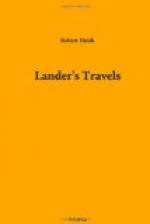The cry of “Allahu akber!” (God is great), the cry of the Fellatas, was resounded through the whole army every quarter of an hour; but neither this nor “Shields to the walls!” nor “Why do not the gadado’s people go up?” had any effect, except to produce a scuffle amongst themselves, when the chiefs would have to ride up and part their followers, who, instead of fighting against the enemy, were more likely to fight with one another. At sunset, the besiegers drew off, and the harmless campaign terminated in a desertion on the part of the Zirmee troops, followed by a general retreat.
The flags of the Fellatas are white, like the French, and their staff is a palm branch. They are not borne by men of honour, but by their slaves. The sultan had six borne before him; each of the governors had two. They also dress in white tobes and trousers, as an emblem of their purity in faith and intention. The most useful personage in the army, and as brave as any of them, was an old female slave of the sultan’s, a native of Zamfra, five of whose former governors, she said, she had nursed. She was of a dark copper colour, in dress and countenance very much like a female esquimaux. She was mounted on a long-backed bright bay horse, with a scraggy tail, crop-eared, and the mane, as if the rats had eaten part of it, nor was it very high in condition. She rode a-straddle, had on a conical straw dish-cover for a hat, or to shade her face from the sun; a short, dirty, white bed-gown, a pair of dirty white loose and wide trousers, a pair of Houssa boots, which are wide, and come over the knee, fastened with a string round the waist. She had also a whip and spurs. At her saddle-bow hung about half a dozen gourds filled with water, and a brass basin to drink out of, and with this she supplied the wounded and the thirsty.




